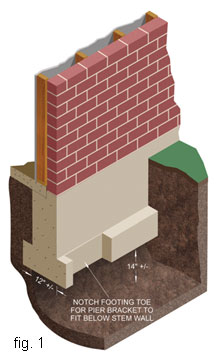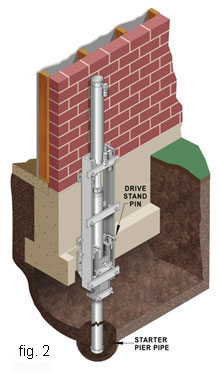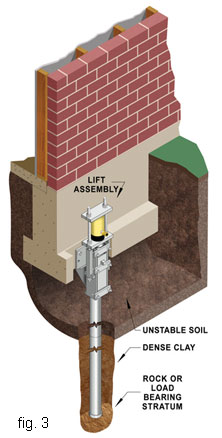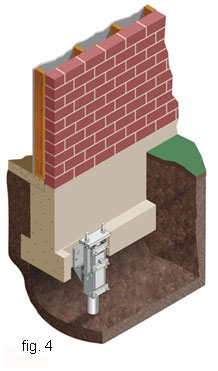The following nine steps provide an overview of the typical pier installation process. [See the detailed ECP Specifications for the company’s specific installation requirements.] For a point of reference, let’s start with Figure 1, which shows a structure with a spread footing.
The job site is evaluated to determine Pier placements and verify the locations of underground utilities.
Access to each placement location is gained by digging small excavations. The space required at the foundation is usually about 3 feet square. (fig. 1)
The footing is notched (if required) to place the pier bracket under the stem wall, preparing the bearing area under the footing to a smooth and level condition, and adjusting the face of the stem wall to vertical (plumb) at the point of bracket attachment. (fig 1)
 Utility Bracket Attachment
Utility Bracket AttachmentThe utility bracket is secured to the footing using anchor bolts. Attachment of the drive stand and the hydraulic cylinder that is used to force the pier pipe into the soil is mounted on the drive stand. (fig 2)
The pier pipe is advanced into the soil using the structure as the reaction force with a 10,000 psi quiet, vibration-free hydraulic pump and cylinder combination.The piers may be installed from outside or inside the structure. Pier installation continues until rock or suitable bearing-strata is encountered below the unstable soil near the surface. (fig 2)
Every pier is load tested by increasing the force on the pier to insure the rock or bearing-strata will support a load greater than needed to guarantee a factor of safety.Typically an engineer will determine the load of the structure and the desired factor of safety before the load tests are performed. (fig 3)
 Preparations for Restoration
Preparations for RestorationOnce all piers have been installed, load tested, and the installation data at each placement recorded, lifting head assemblies and hydraulic lifting rams are placed on the piers.The lifting cylinders are connected with one or more manifolds and operated using a hydraulic pump. (fig 3)
 Restoration
RestorationUnder careful supervision, the load can be immediately transferred from the existing failing strata under the foundation to the load tested piers.The structure is transferred gently and evenly lifted to as close to the original elevation or to the recommendation of the engineer.The nuts at the pier caps are secured at each placement and the lifting equipment is removed. (fig 4) There is no time wasted waiting for concrete to cure.
The soil that was excavated at each pier placement is now replaced and compacted. There is no soil to remove from the site. The site is left clean and neat.Find out more about ECP Steel Piers.
Foundation repair or underpinning projects are usually completed in days, not weeks. Should conditions change, the piers can be easily inspected, tested and/or adjusted. The process is technologically sound, efficient, safe, fast, minimally disruptive, long-lasting and guaranteed.

“…These folks are hard working, helpful, polite, and professional. They will assist you in any way they can… They clean up each day… They explain each days scheduling and the reasons for it… We were relieved to place out home in their hands. It was the right decision….”